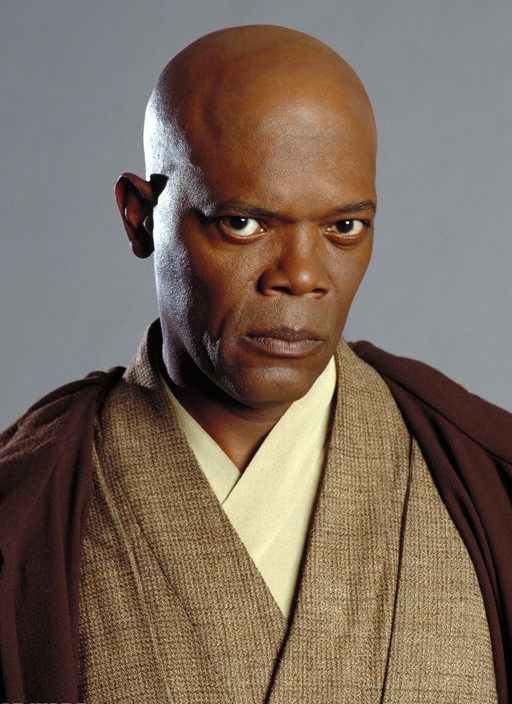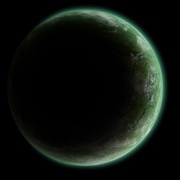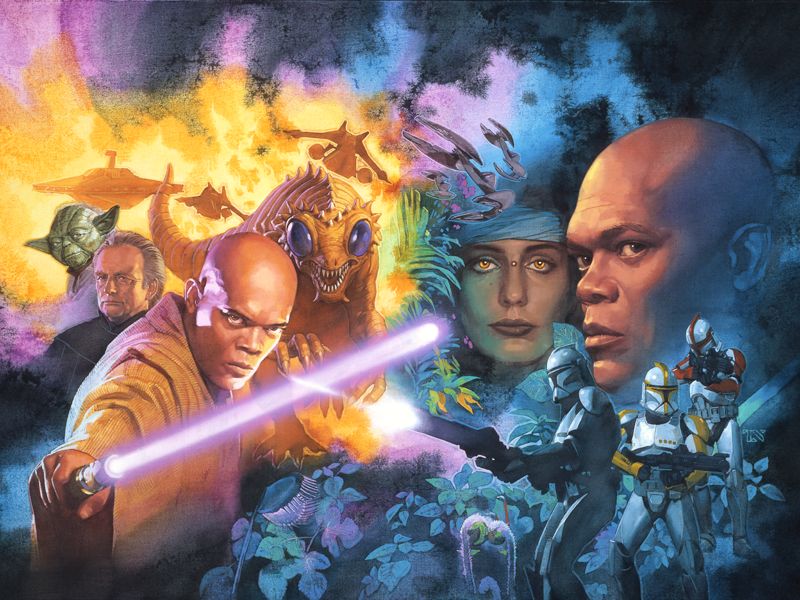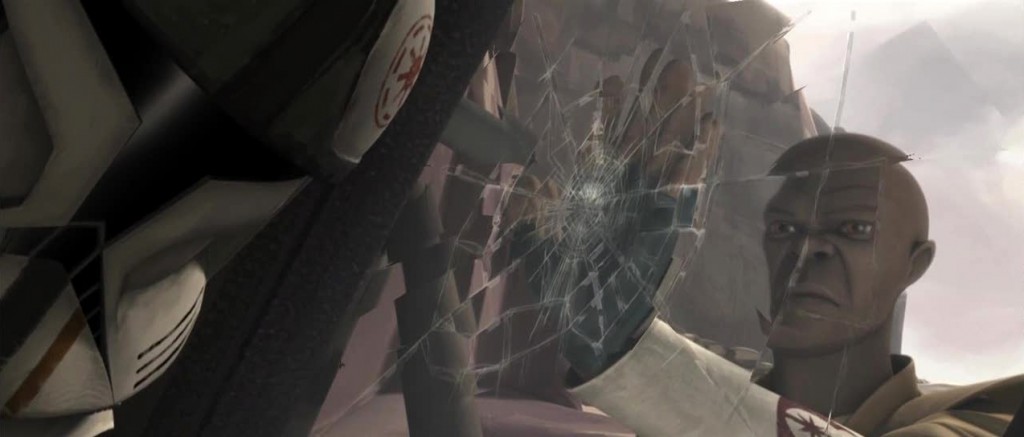WARNING: There be minor spoilers ahead. Read at your own peril!
When reading Shatterpoint, the reader becomes acutely aware of two things: One, this is not Mace Windu as we know him; two: this is most definitely a Matthew Stover novel.
Mace Windu, finely portrayed by Samuel Jackson in the three films, The Phantom Menace, Attack of the Clones and Revenge of the Sith, is seen to be a man of firm resolution, of certainty, of steadfast devotion to the Jedi Order, and the way of the Jedi. He is seen to be one of the finest warriors the galaxy has ever known. A man who fought off an entire droid army single-handedly, who defeated a Sith Lord, who is the bastion of all that is good and right in the galaxy. And, yes, a man who, with one cocked eyebrow, can send you running away to hide behind your sofa. The Mace Windu of this book is all of that. He is known to fight off three gunships unarmed; known to battle his way through hordes of enemies – but he is much more than this.
The Mace Windu we see in this book is also one who has his resolution and certainty in what is right and wrong, good and evil, shaken, and this threatens to fundamentally change him. We see a man of peace shaken by his experiences, the atrocities he has seen – and continues to see, in the course of this book – jar him just as much as any normal human would. Yet, in a way, it’s more so, for him. For Windu, as a Jedi, there is a clear sense of morality, and how he must react, whereas we humans don’t always have to think about that. I personally enjoyed that Windu was more unsure of himself, that depth of character we don’t always see. It is his reaction to it, his strong character development, that is one of, if not the, main event of the book. It is also one of the biggest draw backs.
The story, in my opinion, suffers from pacing issues. The first half, just over 200 pages, out of just over 410 total, are dedicated to Windu, accompanied by several guides – who are there to both protect him, and guard him – walking through the jungle, finding his lost one time apprentice, friend, and fellow Jedi Council member, Depa Billaba, who made an appearance in the first film, The Phantom Menace. Granted, the premise of the book is that Windu must find said lost woman, so it almost makes sense for it to take so long for Windu to find her – except he’s not so much looking for her, as he is being taken to her. The majority of those 200 pages are dedicated to explaining how the the jungle is not evil. How it is not good, nor evil, neither malevolent or benevolent (though, in this case, it certainly seems more malevolent than benevolent), but that it just is what it is. Personally, while I appreciated the fact that he was taking the time to explore this new aspect, taking so long to do so was repetitive and – for lack of a better word – boring, and felt as if my hand was being held the whole time, since I might not understand something new. I doubt that was Stover’s intention, but that’s what it came across as, I felt. Mainly, he extrapolates on something known as ‘the Dark’.
When I say ‘this is most definitely a Matthew Stover novel’, this is what I mean: this is something Matthew Stover is known for. His stories are very often quite violent, as well as being morally ambiguous. This ‘the Dark’ is different from what most fans of the Star Wars franchise know as the Dark Side of the Force, and lends said ambiguity to this story. The classic dark side is still there (that’s something I’ll get round to in the character section), but the Dark leads people to commit acts that would have you, the reader, squirming with discomfort, but it’s written very well – so well, in fact, that sometimes you agree with the shady acts that are performed. Personally, I like that the book has me thinking about these things, whether or not I’d do the same – but it might not be for everyone.
The plot itself is deceptively simple. At the start of the Clone Wars, The Jedi sent Jedi Master Depa Billaba to the strategically placed Separatist (bad guys) held planet of Haruun Kal – which also happens to be Windu’s home planet – to train a resistance against the Separatist forces. She completes this task successfully, but for reasons unknown she stays there, losing contact with Republic forces (good guys). This is brought to the attention of Windu by way of Chancellor Palpatine, the leader of the Republic, in the form of a hologram of a massacre of men, women and children. Unfortunately, this is undeniably the work of Depa and her band of partisans – the Upland Defence Force (ULF).
This evidence is an audio recording from Depa herself. She states:
“I know you will come for me, Mace. You should never have sent me here…. I know you think I’ve gone mad. But I haven’t. What’s happened to me is much worse….I’ve gone sane.”
Admittedly, it’s a cheap gimmick, but I must admit it is effective. Many who go insane often think they’re sane. Based on the cryptic, compelling recording, and reasons that not even he understands, Windu decides to head to Haruun Kal himself. Once there, he’s involved in a brawl, has his Republic contact killed in front of him, is captured by the Lowlanders (the government forces who are allied with the Separatists), is released and is involved in an ambush, and then rescued by and Uplander force led by a man named Nick Rostu. All in his first day. Afterwards, he’s taken by his Upland guides to Depa, and along the way he is brought up to date on the situation. He learns that the Clone Wars on Haruun Kal is just a recent development to a war that has been fought for thirty years between the Lowlanders (Balawai) and the Uplanders (Korunnai): The Summertime War. Eventually, there comes a situation where some of his guides are injured, and so it is decided that they separate: Nick shall go on to find their lor pelek, their healer, and Windu elects to stay with the wounded. He sets up camp at a settlement on the side of an active volcano, which was, until just a day or so ago, a small Lowland settlement. When they arrive there he finds evidence of a massacre – ‘battle’ would not be the right word for it – with the bodies still laying where they fell. There he waits, until he hears the cries of Balawai children, stuck in a crashed speeder, on a cliff, with lava encroaching upon them. This event, while small, I define as the beginning of the true story. Because, afterwards, back at the settlement, he finds a Balawai force on the retreat, and heading directly towards him. On their tail is the ULF, led by the lor pelek: Kar Vastor. This culminates in a fast-paced ending, filled with twists and realisations that left this particular reader admiring how well the story was woven together, and thinking that all the build up in the beginning was worth it (though, to be fair, I still think 50 pages could have been shaved off without being detrimental to the book). Interestingly, even though this book is set during the Clone Wars (it even has the by line ‘a clone wars novel’ on the front cover) the Separatists aren’t the true enemy. Instead, Windu fights the jungle itself, and the ULF – primarily Vastor – and the Lowlanders themselves.
The main cast can be boiled down to just four characters. Windu himself; Nick Rostu; Kar Vastor and Depa Billaba. Windu I’ve discussed, so let’s look at the other three. Nick Rostu is a member of the ULF, Windu’s guide and, later, aide-de-camp. He is the closest thing we have, besides Windu, to a morally correct character. He’s harsh, yet compassionate, baulking at the killing of children, even Balawai children. For this he is deemed weak by his fellow partisans, but it is for this reason that Windu calls on him time and again. His transition from heartless killer to brave hero is most definitely one of the highlights of the book. Too, it helps that he’s the comic sidekick – though, in truth, some of his earlier jokes fall flat. It’s only until later that you find yourself chuckling to his witticisms.
Kar Vastor is an odd creature. The leader of the ULF, he lost his family when he was young and survived a year in the (dangerous, scary, eat you whole and spit out your toe bones) jungle, when he was only a teenager. He lost the ability to speak, and instead communicates in odd jungle noises and, with the power of the Force, he translates inside your head. Stover has said that he represents the Dark Side of the Force. He is a being filled with pure aggression and hate, and acts as the main antagonist of the book.
Depa Billaba is, contrary to her words in the above quote, crazier than Hannibal Lecter. In the short time she’d spent on Haruun Kal, she had become convinced that the Dark of the jungle was all-powerful, and that to resist was useless. Because of this belief, she sent that recording to her erstwhile Master, in order to help him understand the Dark, to embrace it. When she and Windu meet, she spends most of her time either trying to convince him of this, or muttering to herself and shaking back and forth. Daunted, but not yielding, Windu spends the last portion of the book trying to turn her sane. Good luck with that.
There are two final features that I wish to bring to the reader’s attention. One, is Windu’s ability to find ‘Shatterpoints’, which gives a name to this book. This ability allows him to find weak points in structures, events, even people. This plays a prominent role in the telling of the book, yet crucially – at least, it was my impression – it doesn’t impinge on the story on the whole. It’s a device that allows the story to continue, and allows for certain actions to be taken that otherwise would have us readers scratching our heads in bemusement. The other feature is the inclusion of Windu’s Journal. In universe, this is a recording of his thoughts for the Jedi Archives, yet out of universe it provides an interesting twist on the story, and provides us readers an interesting insight into the mind of an inhabitant of the galaxy, far, far away – something which is quite rare. Off the top of my head, I can only think of one other time that’s been utilised, though I’m sure there are more.
Overall, I found it an enjoyable book. The inclusion of Windu’s journal entries was an inspired touch, that made for more gripping reading. Yes, I did find the prose a little difficult to grapple with (especially when we have a change in perspective without a narrative break), and as such further re-readings may help you gain a better appreciation of it, but it’s a decent enough story, and one I could easily recommend.
Author: admin
The Star Wars Report: A Star Wars Podcasting Network and Website.






Amazingly I finished reading this two days ago and completly agree with your statements.
I enjoyed this novel. It’s been a long time since I read it… I should revisit it. 🙂
[…] this series, Shatterpoint, while a decent enough book (you can read my thoughts on the book in an earlier review on this site), didn’t really involve clones until the very end, and their presence […]